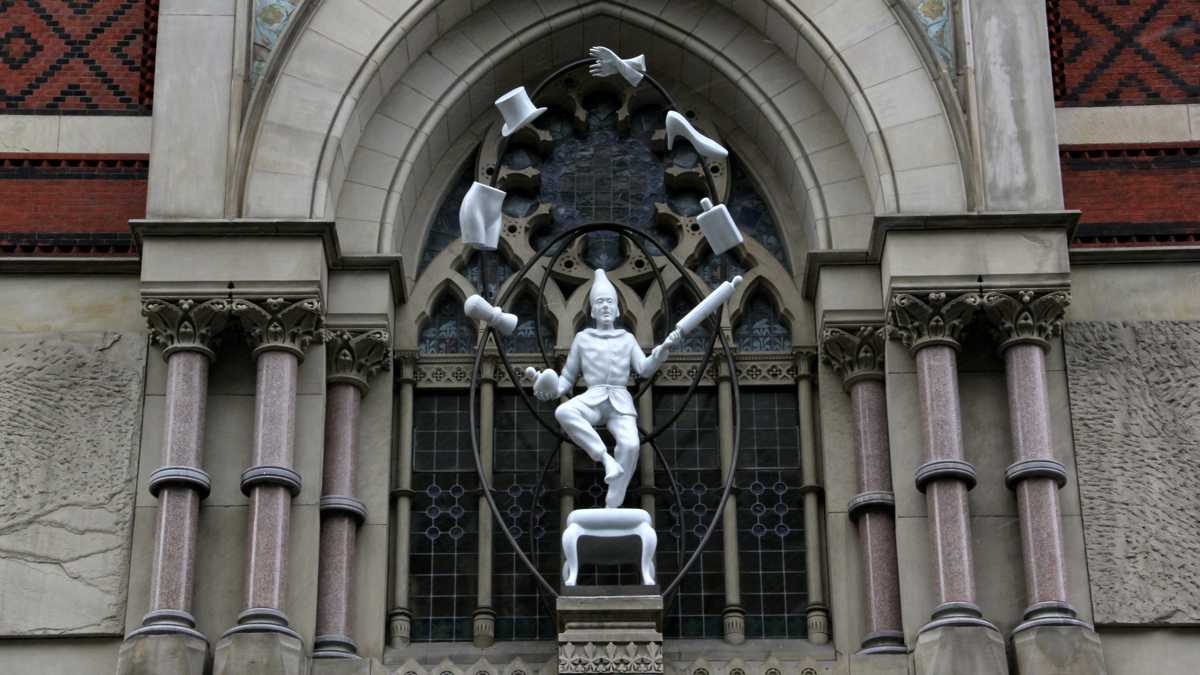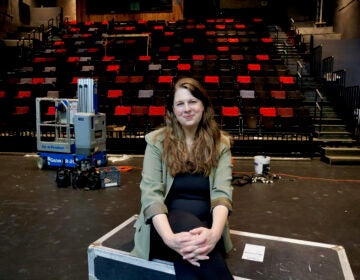Sculpture above Academy of the Fine Arts entrance packs a Punch

'Young Punch Juggling' by Connecticut-based artist Robert Taplin is the second in an ongoing series of temporary sculptures erected onto the façade of PAFA's historic building on North Broad Street. (Emma Lee/WHYY)
You don’t see too many buildings with a plinth about the door, anymore. The small platform built into a building façade to support a statue is from an old style of architecture, a style architects Frank Furness and George Hewitt were playing with when they designed the home of the Pennsylvania Academy of the Arts in 1871.
The plinth on Broad Street had been empty for years, until PAFA started commissioning new work to fill the space. In January, artist Robert Taplin installed a 16-foot figure of a jester juggling household items.
He had mischief in mind.
The figure is Punch, a character from 16th century Italian commedia dell’arte tradition. He is a clownish figure who is always poking fun at authority and getting into trouble – all libido and id. The English later borrowed him for their “Punch and Judy” puppet shows. He often has a hunchback, a hook nose, and a freakish personality.
“He’s a collection of things we are scared of,” said Taplin, who bases much of his work on Punch. “He also is at his liberty. As an outsider, as someone who doesn’t fit into the norms and parameters of society and kind of goes his own way, he’s both an object of horror and envy.”
Taplin installed several small pieces throughout the museum of the Pennsylvania Academy of the fine Arts, including Punch receiving some kind of public award, and Punch have vigorous sex with someone who appears to be aristocratic. The white sculptures are dipped in wax, to give them a softly rounded look.
PAFA also commissioned Taplin to also make two new, large-scale sculptures for the interior of the building. One of them is “Punch Making a Public Confession,” wherein he appears to be a contrite politician.
“Within this theater of modern public life, we’re constantly in a position of trying to assess authenticity of figures through the media. We’ve come to realize this is slippery turf,” said Taplin. “There’s a theatrical aspect to contemporary life, which Punch is very happy with. This is where he operates, where nobody is sure where the ground is.”
Because Punch is usually on the margins of society, Taplin made a second large sculpture of him as a homeless person, suggesting he is socially invisible while living in plain sight.
WHYY is your source for fact-based, in-depth journalism and information. As a nonprofit organization, we rely on financial support from readers like you. Please give today.





